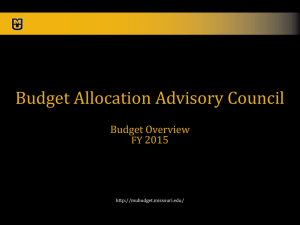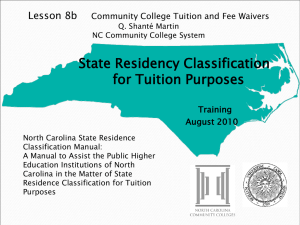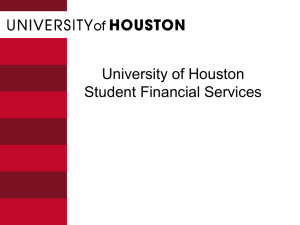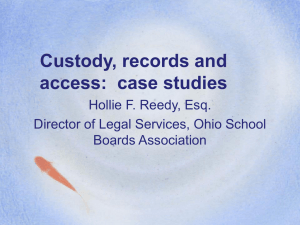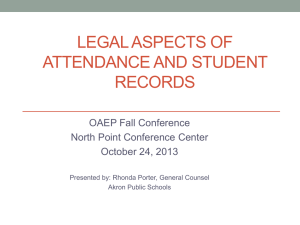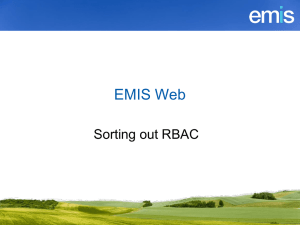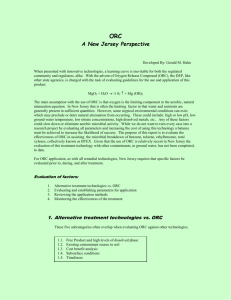Document
advertisement
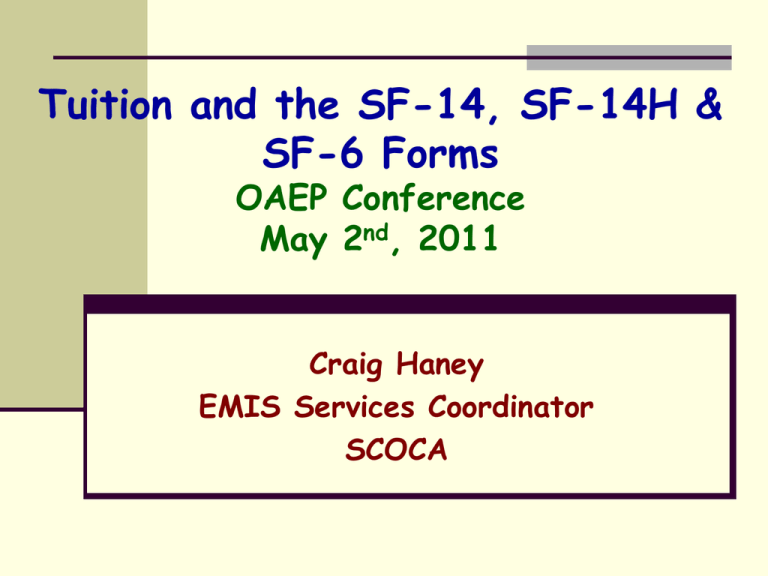
Tuition and the SF-14, SF-14H & SF-6 Forms OAEP Conference May 2nd, 2011 Craig Haney EMIS Services Coordinator SCOCA The presenter is not responsible for any changes that have occurred in the past ten minutes nor for any that my occur within the next two. Regarding Today’s Presentation I didn't say that I didn't say it. I said that I didn't say that I said it. I want to make that very clear. Topics What Is “Tuition”? What Determines “Residency”? What Determines a “Home”? How Is Tuition Determined? How May I Bill For Tuition? When Do I Bill For Tuition? Sample SF-14 Forms EMIS Coding and the SF-14 Special Situations and Billing Questions What is “Tuition?” Tuition is an amount of money paid to a school district to offset the district’s cost of educating a student who is a legal resident of another school district. Tuition substitutes for the local tax dollars received by a school district to educate their resident students. How is tuition calculated? Based on the previous year’s taxes charged and payable divided by the previous year’s ADM. The tuition amount for each school district is set annually by ODE and is paid by the parents or the school district where the parents reside. Required by ORC 3327.06 What Determines “Residency”? Residence of the Child=Residence of his or her parent. “Parent” can be Natural or Adoptive Divorced Parents – “Parent” will be the residential parent and legal guardian Grandparent may gain legal status of a “parent” via the Grandparent Caretaker Law Guardianship – does not affect the obligation to pay tuition Guardian must have legal custody What Determines “Residency”? (cont’d.) A child may be able attend tuition free in two districts if parents reside in different districts and both have joint custody. A child may not attend tuition free in two districts because residential property straddles a district boundary line. “Residency” is determined by where house is located. What Determines “Residency”? (cont’d.) Criteria to determine “Residency” Conclusion reached based on consideration of all circumstances Where parent sleeps the majority of the time Where mail is received Where meals are eaten Voter registration. Who has the final say in disputed “residency”? Superintendent of Public Instruction Common Pleas court has no jurisdiction until the SPI has made a decision What Determines a “Home”? Children in a “Home” A. In the custody of a governmental agency, or B. Someone other than their natural or adoptive parents, or C. Are in need of special education Definition of a “Home” A. Defined as any home, institution, foster home, group home or other residential facility. B. Must be licensed or certified by the state C. Operated by a state certified/licensed individual D. Has accepted the child via placement by a certified/licensed individual How May I bill for Tuition? Tuition is to be billed by the educating district for the following: Court Ordered Foster Placement Court Ordered Institutional Placement Parental Institutional Placement What “forms” are used when billing for tuition? The SF-14 to be used for all students without disabilities. The SF-14H to be used for all students with a disability. The SF-14H will recover only “local dollars”, not weighted handicap dollars. When Do I Bill For Tuition? Both the SF-14 and SF-14H forms are to filed with the Area Coordinators as follows: Two filing “periods”: July through December Filing Deadline is February 1st January through June Filing Deadline is August 1st Tuition billing based on days “in session”, not by attendance days. Days in session may not exceed 180 total. The SF-14 Form The SF-14H Form The SF-14H Form, cont’d. EMIS Coding, The Pass Flow and the SF-14 Forms The Pass Flow report will determine: The EMIS code for students qualifying for SF-14 billing. The district of residence for qualifying students Note: A court order has the final say when determining the “responsible” district. Districts may request a change of residency through ODE if they can show evidence that the parent is living and paying taxes in another district. EMIS Coding, cont’d. Special Situations and Billing What if I feel my district is not responsible? SF-14 Situation If you don’t have court order naming the responsible district, refer to ORC 3313.64 C-(2) a, b and c. SF-14H Situation Refer to ORC 3323.01 M-1-2-3 Court Oder Determining Who Pays SF-14 Situation ORC 3313.64 C-(2) a, b and c. a) Parent residence at the time of court removal or when the court vested legal custody in a person or agency, whichever occurs is first. b) If the parent’s residence at the time a) occurs is unknown, tuition shall be paid by the district in which the child resided at the time of court removal or vested custody, whichever occurs is first. c) If a school district cannot be established under a) or b),tuition shall be paid by the district determined by ORC 2151.362 by the court at the time it vests custody. Determining Who Pays, cont’d. SF-14H Situation ORC 3323.01 M-1-2-3 1. The school district in which the child’s natural or adoptive parents reside. 2. If the school district specified in division 1) cannot be determined, the last district in which the child’s natural or adoptive parents are known to have resided if the parents’ whereabouts are unknown; 3. If the district specified in division 2) of this section cannot be determined, the district determined under ORC 2151.362, or if no district has been so determined, the probate court of the county in which the child resides determines the responsible district. Determining Who Pays, cont’d. Court Order 1. “Pay up” 2. Ask the courts to change the district of responsibility 3. Request that ODE determine the “DOR” based on evidence provided. a. Voter Registration b. Utility Bills c. Tax Duplicate The SF-6 What is an SF-6? The SF-6 is filed when the total cost of educating a non-resident student exceeds the state basic aid plus the weighted funding. Known as “excess costs”. May be filed with the SF-14H if any one of three boxes checked “yes”. If none of the three boxes have been checked yes, the SF-6 will be rejected. Can also be filed for handicapped open enrollment students attending. In the case of open enrollment, the weighted amount remains with the resident district. Contractual Agreements In lieu of the SF-6, districts may enter into contracts for paying excess costs. Saves a lot of paperwork and time. Could save the responsible district funding. Catastrophic Costs What are “catastrophic costs”? Applies when the cost of educating a handicapped student exceeds ODE established “thresholds”. Categories 2 through 5 = $27,375.00 Category 6 = $32,800.00 A two fold formula determines additional funding to be credited to the educating district. Filed with ODE, not the resident or “responsible” district. Who May Attend Tuition Free? (Under ORC 3313.64) Mandatory Admission Self-Supporting Students Married Student Child Placed for Adoption Medical Condition Parent in Armed ServiceOutside the State/Nat’l Guard or Reserve unit New House Being BuiltContract to Purchase Victim of Domestic Violence – In a Child Shelter Military Power of Attorney Permissive Admission Custody Proceedings Initiated Foreign Exchange Students Death of a Parent Children of School Employees Senior Year-Parent Moves Grandparent Law ** Non-handicapped only Superintendents Agreement Student Relocates After the October Count Week McKinney-Vento Homeless Assistance Act In Summary When submitting any of the aforementioned forms, you must use the SSID number and not the student name. When in doubt, refer all billing questions to your area coordinators. Review your PASS Flow reports. Make sure your students are coded correctly with respect to district of residence and EMIS situations. Make sure the handicap condition is properly reported as weighted amounts are generated from this. EMIS coordinators should work closely with their treasurer in these situations. Questions?
